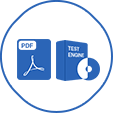Last Update 7 hours ago Total Questions : 249
The GRC Professional Certification Exam content is now fully updated, with all current exam questions added 7 hours ago. Deciding to include GRCP practice exam questions in your study plan goes far beyond basic test preparation.
You'll find that our GRCP exam questions frequently feature detailed scenarios and practical problem-solving exercises that directly mirror industry challenges. Engaging with these GRCP sample sets allows you to effectively manage your time and pace yourself, giving you the ability to finish any GRC Professional Certification Exam practice test comfortably within the allotted time.
What is the role of an assurance provider in the assurance process?
What is the term used to describe a measure that estimates the likelihood and impact of an event?
Which category of actions & controls in the IACM includes formal statements and rules about organizational intentions and expectations?
In the context of GRC, what is the importance of aligning objectives throughout the organization?
What are norms?
In the IACM, what is the role of Promote/Enable Actions & Controls?
What is the relationship between the internal context and the culture of an organization within the LEARN component?

